Musée de Picardie, Amiens
Reviewed by David O’BrienDavid O’Brien
Professor of Art History
University of Illinois Urbana Champaign
Email the author: Obrien1[at]Illinois.edu
Citation: David O’Brien, installation review of Musée de Picardie, Amiens, Nineteenth-Century Art Worldwide 21, no. 3 (Autumn 2022), https://doi.org/10.29411/ncaw.2022.21.3.11.
This work is licensed under a Creative Commons Attribution-NonCommercial 4.0 International License  unless otherwise noted.
unless otherwise noted.
Your browser will either open the file, download it to a folder, or display a dialog with options.
Art historians associate Amiens first and foremost with its magnificent Gothic cathedral. Oddly, the city’s fine arts museum, the Musée de Picardie, remains little known, despite its superb nineteenth-century building and collections. Partially closed since 2008, and wholly from 2017 to 2020, the renovated museum has now been open for two years, with its collection reinstalled under the direction of Laure Dalon. The stunning result makes obligatory the short trip from Paris to Amiens, at least for true dix-neuvièmistes.
Amiens owes its museum to the work of a local organization, founded in 1836 as the Société d’Archéologie du Département de la Somme, and then, after 1839, known as the Société des Antiquaires de Picardie. Amiens had missed out on the distributions of art made by the Napoleonic regime, but this group acquired and built various local archaeological and artistic collections and safeguarded objects threatened by urbanization and the nationalization of religious patrimony. Between 1854 and 1865, with the proceeds from a national lottery and important help from the Second Empire, it erected a luxurious palace for its collections—the first building outside of Paris expressly constructed as a fine arts museum and a prototype for many other municipal palais des beaux-arts that would follow.
The museum possesses excellent collections in several areas, but a variety of circumstances contributed to its special strength in nineteenth-century French art. The municipality acquired some forty pieces between 1836 and 1914 from an annual exhibition organized by the Société des Amis des Arts du Département de la Somme. The Louvre donated fifty-one paintings for the museum’s opening in 1864, most of them from the nineteenth century, and the state regularly sent works purchased at the Salon for the rest of the century. There were also numerous donations from private collectors over the course of the nineteenth and early twentieth centuries. The result of this patronage, dominated by official institutions and mainstream artistic societies, is a collection strong in academic art. There is not a single impressionist painting on display in the museum (gasp!), and very few that could be characterized as postimpressionist. There are a few canonical works—e.g., Constance Charpentier’s Melancholy (1801)—and some work by canonical artists—e.g., a late, anthropomorphizing landscape by Gustave Courbet and some Barbizon painting—but many of the nineteenth-century painters represented in the collection fared better in their own day than in ours. If you enjoy employing the word “pompier” to dismiss conventional nineteenth-century painting and sculpture, perhaps the Musée de Picardie is not for you. On the other hand, if you wish to immerse yourself in the artistic standards that reigned for most of the nineteenth century in France, few museums outside of Paris can compare.
The museum’s staff frequently refers to the building, which is primarily the work of Arthur Diet, as “the first object in the collection.” The renovation does not slavishly recreate the building’s original form and décor, which would have been impossible in any case because there were important and irreversible additions and changes already in the nineteenth century. The three main facades of the building remain unaltered and have been entirely restored. They are the image of Second Empire architecture, with decorative use of metal to accent the stone walls, high roofs inspired by the new Louvre of Napoleon III, and rich sculptural decorations by Eugène Louis Lequesne, Jean Debay, and Louis and Aimé Duthoit (fig. 1). As with the decoration everywhere in the building, there are allusions to regional history, the glory of the Second Empire, and great artists. The main courtyard also remains. Its niches once contained reassembled monuments rescued from around Picardy, in the manner of Alexandre Lenoir’s Musée des Monuments Français. These are long gone, but the walls and two basins with griffons have been restored, as have the enclosing cast-iron gates. Modern masonry and plantings cover the court. The entrance is now through an early twentieth-century addition, originally at the rear of the museum, which has been joined to new construction housing the museum’s offices, technical spaces, an auditorium, and various services for visitors (fig. 2). The contemporary addition alludes to the architecture of the old, but does not obtrude, as it is modestly sleek, functional, and invisible to the viewer when viewing the original front of the museum.
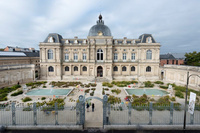
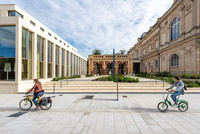
While the restoration of the exterior is a tribute to nineteenth-century architecture, it is the interior that truly allows the visitor to step back in time. Most of the original interior spaces were elaborately decorated from floor to ceiling. The renovation has restored the original forms of many galleries, their wall colors and decorative programs, their parquets and marquetries, and the glasswork in the windows. Diet designed most of the principal spaces, including a vaulted, neo-Gothic “chapel” in which Christian antiquities were to be displayed (fig. 3). The library and meeting room of the Société des Antiquaires de Picardie, built over the course of the Second Empire and the first decade of the Third Republic, have been restored to a working state (fig. 4). The handsome rooms are visible through two entryways and constitute a sort of monument to nineteenth-century bourgeois learned societies.
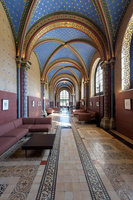
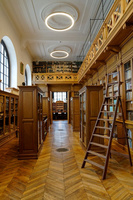
Two of the restored areas are particularly dazzling. The Grand Staircase (fig. 5) and adjoining Salon of the Emperor (fig. 6) have all the pomp and splendor that you would expect in a nineteenth-century French city’s monument to art and to itself. Every surface is decorated. The central dome in the Salon of the Emperor features paintings by Félix Barrias, and there are numerous sculptural decorations, most notably by Camille-Auguste Gastine, Charles Chauvin, Auguste Préault, and Auguste Rodin. The space is rendered especially significant by the contributions of Pierre Puvis de Chavannes. Puvis had exhibited two large mural paintings at the Salon of 1861, Concordia and Bellum, which he had made without a destination in mind. The state acquired the first, and Puvis donated the second, in order that the pendant pair not be broken up. Diet convinced the government to give them to Amiens in 1863. The following year Diet acquired another pendant pair by Puvis, Work and Repos, which the state had declined to purchase from the Salon of 1863. Puvis visited the museum in 1864 and painted four tall, narrow allegorical figures for the fenestrated walls across from Concordia and Bellum in the Salon of the Emperor, and two oval paintings for the space above them. Work and Repose went on the side walls of the staircase, which eventually also received smaller allegorical paintings as overdoors. Then, in 1865, he covered one of the long walls of the staircase with Ave Picardia Nutrix, a paean to the fertility of Picardian agriculture and the first of his many commissions expressly made for museums and libraries. His cycle was completed in 1888, when his Pro Patria Ludus covered the final wall of the staircase (fig. 7), constructed in part to enclose the space that became the Grand Salon. In sum, the Musée de Picardie holds a major place in the career of one of the century’s most important muralists.
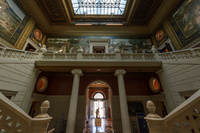
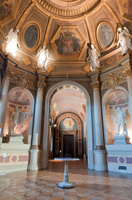

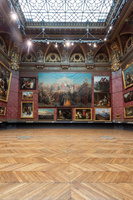
The centerpiece of the museum is the Grand Salon (fig. 8), a large gallery that recalls the Salon Carré at the Louvre. It had been envisioned by the museum from the start but was only realized, in the place of an interior courtyard, in 1890. It is now entirely restored to its original decor. There are enormous cornices ornamented with richly sculpted allegories, portrait busts in medallions, and large moldings, all with ample gilding and paint; crimson walls patterned with monograms and emblems, suggesting a tapestry; and a glass ceiling. The gallery is hung in the style of the nineteenth century, with paintings covering most of the wall space, though the hanging is less crowded than it would have been at the Salon in its heyday, and all the paintings are medium to large format. The sumptuousness of the gallery is undercut by the fact that at least ten of the paintings in the room lack proper frames, but the illusion of having stepped into the nineteenth century is nonetheless striking.
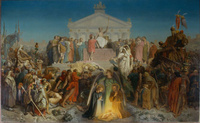
Three walls of the gallery are devoted to the nineteenth century, with the fourth being left to the eighteenth century. The main story these tell is of a classicism centered on the male body, but the artists who figure in it are largely absent from or come after the now well-known accounts of classicism from the Revolution to the Restoration.[1] The artists represented include François-Édouard Picot, Merry-Joseph Blondel, Pierre Claude François Delorme, Jean-Baptiste Mauzaisse, Jean-Victor Schnetz, Charles-Philippe Larivière, Martin Drolling, François-Hippolyte Debon, Gustave Rodolphe Boulanger, and Joseph-Noël Sylvestre. Of special note is Jean-Léon Gérôme’s The Century of Augustus: The Birth of Jesus Christ (fig. 9), an immense painting exhibited at the Exposition Universelle of 1855. The painting draws on paintings by J.-A.-D. Ingres and Paul Delaroche to create a pantheon of great figures from around the time of Augustus and includes the infant Jesus in the foreground. A panoply of ethnographic stereotypes of the various peoples of the Roman Empire looks on. This bizarre scene was meant to provide an allegory for the temporal and spiritual glories on Napoleon III’s reign.
There are other aspects of the nineteenth century on display, including the belated response of painters to the defeat and suffering that accompanied the fall of the Napoleonic regime (e.g., Édouard Odier, Dragon of the Imperial Guard. Study [1832]; Hippolyte Bellangé, The Last Line of Defense of the Guard at Waterloo [1849]). What lends the most period flavor to the gallery are, however, several large paintings whose subjects are so dated as to potentially offend today’s viewers. For example, Horace Vernet’s Massacre of the Mamelukes (1819) is an excellent demonstration of how the nineteenth century displaced excess and violence onto the colonial world, and Jules Lefebvre’s Lady Godiva (fig. 10), a smash hit at the Salon of 1890, shamelessly gratifies a voyeuristic taste for the sexualized humiliation of women. These paintings are given central places in the hang and otherwise presented without judgement, leaving viewers to draw their own conclusions.
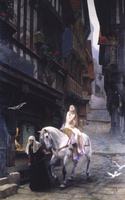
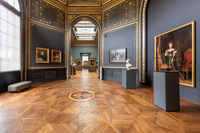
The museum’s collection of nineteenth-century paintings occupies approximately half of the galleries on the second floor. The work is installed in a roughly chronological order, and many of the key artistic developments in Salon painting are evident (fig. 11). There are good examples of neo-rococo, troubadour, and anecdotal history painting. A corner gallery displays an assortment of Orientalist, Spanish, and Italian exotica from across the century. The curation is notable for clever pairings and thoughtful transitions between sections. Paintings of sea voyages, shipwrecks, and dead bodies surround an interesting copy of Théodore Géricault’s Raft of the Medusa, done ca. 1859 when it became evident the original was disintegrating. Portraits and paintings of single figures are dispersed throughout, providing a unifying thread. Nudes by Léon François Comerre, Jean-Jacques Henner, and Paul Sérusier make the transition from the nineteenth to the twentieth century, highlighting the dissolution of the figure in the hands of figures like Pablo Picasso, Francis Picabia, and André Masson, whose work follows. A large interior gallery is divided by partitions, with each section answering a particular charge of the museum. One end is devoted to commemorating the studio, career, and artistic ideals of Albert Maignan, a major figure in Amiens artistic life and contributor to the museum. The middle portion displays the work of Picardian artists and paintings of Picardy and nearby regions. The other end of the gallery is devoted primarily to pictures of children.
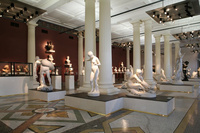
Nineteenth-century sculpture is allotted a gallery on the first floor (fig. 12). Its original mosaic floor has been exposed, as have parts of its original wall and ceiling decorations. Of note are Augustin-Alexandre Dumont’s Love Tormenting the Soul (1827), whose beautifully finished, crystalline marble has been slightly marred at the knees of the figure by the touch of visitors, and Louis-Léon Cugnot’s Coryborant Covering Up the Cries of the Infant (1867), whose main figure displays his virile anatomy in an unusual, spiraling pose. The collection reveals a predilection for nude figures of young and very young girls, among whom Psyche looks like an older sister. There are also Ledas, Eves, and Clyties in the usual languorous and sexualized poses, and an abundance of portrait busts.
Throughout the museum, audio visual aids are kept to a refreshing minimum, but a large touch screen monitor in the Grand Salon, discreetly confined to one corner, provides interactive lessons about the techniques used in Maignan’s Voices of the Tocsin (1888). Almost every gallery contains larger plaques explaining the main themes on display. Labels of works of art are almost always accompanied by brief, one-paragraph explanations. The reopening of the museum has been accompanied by two excellent publications, one surveying the history of the museum and its architecture, and the other providing a guide to its collections. They lack extensive documentation, but they are well worth purchasing by a university library.[2]
Perhaps more than for any other period, specialists of nineteenth-century French art have focused on Paris to the virtual exclusion of the rest of the country. This emphasis is encouraged by the centralization of the French state and French cultural life in the capital, and contrasts markedly with the histories of art for countries such as Germany and the United States. There have been good studies of art institutions in nineteenth-century French provincial cities, but by and large researchers today use resources available in and around Paris.[3] Of course, the building and collections of the Musée de Picardie were themselves created in no small part in relation to developments in Paris, but they also have much to say about the region and about cultural elites generally in the provinces in the nineteenth century. Above all else, they richly illustrate a side of nineteenth-century French art that would all but disappear from art history over the course of the twentieth century. This alone, not to mention the clean air and delightful canals of Jules Verne’s adopted city, merits an excursion to Amiens.
Notes
[1] For example, Thomas Crow, Emulation: Making Artists for Revolutionary France (New Haven: Yale University Press, 1995) and Abigail Solomon-Godeau, Male Trouble: A Crisis in Representation (London: Routledge, 1997).
[2] Laure Dalon and Jean-Loup Legay, ed., Musée de Picardie. Guide Historique & Architectural (Lille: éditions inventit, 2020) and Laure Dalon and Catherine Renaux, ed., Musée de Picardie. Guide des collection (Lille: éditions inventit, 2020).
[3] Daniel Sherman, Worthy Monuments: Art Museums and the Politics of Culture in Nineteenth-Century France (Cambridge, MA: Harvard University Press, 1989); Arnaud Bertinet, Les musées de Napoléon III (Paris: Mare & Martin, 2015); Chantal Georges, ed., La Jeunesse des musées, exh. cat. (Paris: Réunion des musées nationaux, 1994).